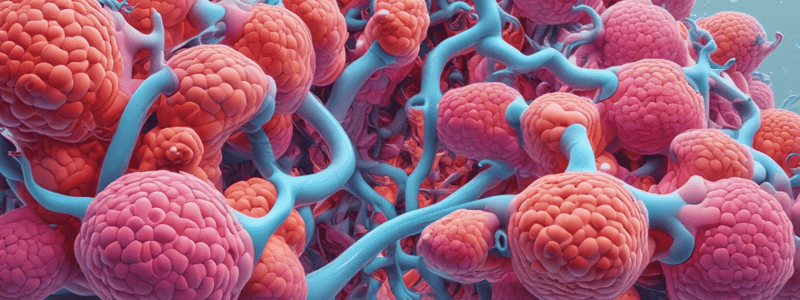Podcast
Questions and Answers
What can cause or be a risk factor for ARDS?
What can cause or be a risk factor for ARDS?
- Younger age
- Chronic alcohol abuse (correct)
- Normal metabolism
- None of the above
Which of the following is not a cause or risk factor for ARDS mentioned in the text?
Which of the following is not a cause or risk factor for ARDS mentioned in the text?
- Older age
- Metabolic acidosis
- Younger age (correct)
- Chronic alcohol abuse
Which of these is a risk factor for ARDS according to the text?
Which of these is a risk factor for ARDS according to the text?
- Normal alcohol consumption
- Metabolic acidosis (correct)
- Younger age
- Good metabolism
What does the text say can contribute to the development of ARDS?
What does the text say can contribute to the development of ARDS?
Which of the following is NOT a potential cause or risk factor for ARDS?
Which of the following is NOT a potential cause or risk factor for ARDS?
What is a pleural effusion?
What is a pleural effusion?
What types of pleural effusions are mentioned in the text?
What types of pleural effusions are mentioned in the text?
What is a serous pleural effusion?
What is a serous pleural effusion?
What is a proteinaceous pleural effusion?
What is a proteinaceous pleural effusion?
What other types of pleural effusions are mentioned?
What other types of pleural effusions are mentioned?
What type of cytokines do the cells release instead of those that induce a normal or minimal inflammatory response?
What type of cytokines do the cells release instead of those that induce a normal or minimal inflammatory response?
What is the primary effect of the cytokines released by these cells?
What is the primary effect of the cytokines released by these cells?
What is the primary function of eosinophils in the context of the cytokines released by these cells?
What is the primary function of eosinophils in the context of the cytokines released by these cells?
What is the main difference between the cytokines released by these cells and the cytokines that induce a normal or minimal inflammatory response?
What is the main difference between the cytokines released by these cells and the cytokines that induce a normal or minimal inflammatory response?
What is the likely outcome of the overproduction of mucus caused by the cytokines released by these cells?
What is the likely outcome of the overproduction of mucus caused by the cytokines released by these cells?
Where does the exchange of gases occur in the respiratory system?
Where does the exchange of gases occur in the respiratory system?
What substances are exchanged at the alveoli?
What substances are exchanged at the alveoli?
Which of the following is NOT involved in the process of gas exchange in the lungs?
Which of the following is NOT involved in the process of gas exchange in the lungs?
What is the primary function of the alveoli?
What is the primary function of the alveoli?
Which of the following is correct regarding the direction of gas exchange at the alveoli?
Which of the following is correct regarding the direction of gas exchange at the alveoli?
What is the approximate time range for the protracted late phase of an allergic reaction?
What is the approximate time range for the protracted late phase of an allergic reaction?
Which of the following immune cells are recruited to the submucosa during the protracted late phase?
Which of the following immune cells are recruited to the submucosa during the protracted late phase?
What is the primary factor that leads to the recruitment of immune cells during the protracted late phase?
What is the primary factor that leads to the recruitment of immune cells during the protracted late phase?
Which of the following is NOT a characteristic of the protracted late phase?
Which of the following is NOT a characteristic of the protracted late phase?
What is the primary function of the recruited immune cells during the protracted late phase?
What is the primary function of the recruited immune cells during the protracted late phase?
Flashcards are hidden until you start studying




